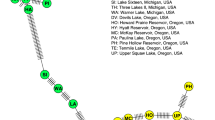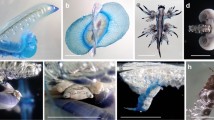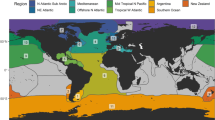Abstract
A new harpacticoid copepod species was found during a year round plankton survey in a shallow Antarctic bay. Both the dominant Calanoida and Cyclopoida and the often neglected Harpacticoida, their abundances in relation to sea-ice formation and decline in presence of Euphausia superba are regarded, in this study. Alteutha potter sp. n. (Peltidiidae) was collected in Potter Cove, King George Island, Antarctica. While its geographical region occurrence and planktonic life style are comparable to many of its congeners, morphological characters such as shape and setation of the maxilliped and the almost complete fusion of the baseoendopod and the exopod of the fifth leg in the female are described for the first time for this genus. Morphological peculiarities such as the lack, the deformation or fusion of setae on only one body side have been detected in several specimens. This copepod species is obviously sea-ice related. Its abundances in the plankton reached a maximum under the winter sea-ice. The year round population structure did not show very high variability whereas ovigerous females mostly occurred in spring and summer. Assuming different possible ecological strategies and environmental temperatures generation times between 46 and 77 days are calculated for A. potter sp. n.












Similar content being viewed by others
References
Alheit, J. & W. Scheibel, 1982. Benthic harpacticoids as a food source for fish. Marine Biology 70: 141–147.
Apostolov, A., 1973. Apport vers l’étude d’Harpacticoïdes pontiques habitant les algues marines. Zoologischer Anzeiger 191: 263–281.
Atkinson, A. & J. M. Peck, 1988. A summer–winter comparison of zooplankton in the Oceanic area around South Georgia. Polar Biology 8: 463–473.
Atkinson, A. & R. Snyder, 1997. Krill-copepod interactions at South Georgia, Antarctica, I. Omnivory by Euphausia superba. Marine Ecology Progress Series 160: 63–76.
Atkinson, A., P. Ward, A. Hill, A. S. Brierley & G. C. Cripps, 1999. Krill-copepod interactions at South Georgia, Antarctica, II. Euphausia superba as a major control on copepod abundance. Marine Ecology Progress Series 176: 63–79.
Brady, G. S., 1899. On the marine copepoda of New-Zealand. Transactions of the Zoological Society London 15: 31–54.
Chiba, S., T. Ishimaru, G. W. Hosie & M. Fukuchi, 2001. Spatio-temporal variability of zooplankton community structure off east Antarctica (90–160°E). Marine Ecology Progress Series 216: 95–108.
Chojnacki, J. & T. Weglenska, 1984. Periodicity of composition, abundance and vertical distribution of summer zooplankton (1977/1978) in Ezcurra Inlet, Admiralty Bay (King George Island, South Shetland). Journal of Plankton Research 6: 807–827.
Coull, B. C., 1990. Are members of the meiofauna food for higher trophic levels? Transactions of the American Microscopical Society 109: 233–246.
Coull, B. C. & M. A. Palmer, 1984. Field experimentation in meiofaunal ecology. Hydrobiologia 118: 1–19.
Dahms, H.-U., 1992. Peltidiidae (Copepoda, Harpacticoida) from the Weddell Sea (Antarctica). Zoologica Scripta 21: 181–195.
Dahms, H.-U., M. Bergmans & H. K. Schminke, 1990. Distribution and adaptations of sea ice inhabiting Harpacticoida (Crustacea, Copepoda) of the Weddell Sea (Antarctica). Marine Ecology 11: 207–226.
Elwers, K. & H.-U. Dahms, 1998. Species composition and seasonal population structure of Oithona similis (Copepoda, Cyclopoida) in the Potter Cove (Jubany, King George Island, Antarctica). Berichte zur Polarforschung 299: 150–155.
Feller, R. J. & V. W. Kaczynski, 1975. Size selective predation by juvenile chum salmon (Oncorhynchus keta) on epibenthic prey in Pudget Sound. Journal of the Fisheries Research Board Canada 32: 1419–1429.
Feller, R. J. & R. M. Warwick, 1988. Energetics. In Higgins, R. P. & H. Thiel (eds), Introduction to the Study of Meiofauna. Smithsonian Institution Press, Washington, 181–196.
Freire, A. S., M. J. Coelho & S. L. C. Bonecker, 1993. Short term spatial–temporal distribution patterns of zooplankton in Admiralty Bay (Antarctica). Polar Biology 13: 433–439.
Fukuchi, M. & A. Tanimura, 1980. A preliminary note on the ocurrence of copepods under sea ice near Syowa Station, Antarctica. Memoirs of the National Institute of Polar Research (Japan), Series E, Biology and Medical Science 34: 37–43.
Gee, J. M., 1987. Impact of epibenthic predation on estuarine intertidal harpacticoid copepod population. Marine Biology 96: 243–261.
Giere, O., 1993. Meiobenthology. Springer-Verlag, Berlin.
Goodsir, H., 1845. On several new species of crustaceans allied to Saphirina. Annals and Magazine of Natural History 16: 325–327+pl.
Gradinger, R., 2001. Adaptation of Arctic and Antarctic ice metazoans to their habitat. Zoology 104: 339–345.
Günther, S., K. H. George & M. Gleitz, 1999. High sympagic metazoan abundance in platelet layers at Drescher Inlet, Weddell Sea, Antarctica. Polar Biology 22: 82–89.
Hagan, M. T., H. B. Demuth & M. H. Beale, 1996. Neural Network Design. PWS Publishing Company.
Hicks, G. R. F., 1982. Porcellidiidae and Peltidiidae (Copepoda: Harpacticoida) from the marine algae of St. Croix Island, Algoa Bay, South Africa. Zoological Journal of the Linnean Society 75: 49–90.
Hicks, G. R. F., 1986. Phylogenetic relationships within the harpacticoid copepod family Peltidiidae Sars, including the description of a new genus. Zoological Journal of the Linnean Society 86: 349–362.
Hicks, G. R. F. & B. C. Coull, 1983. The ecology of marine meiobenthic harpacticoid copepods. Oceanography and Marine Biology Annual Review 21: 67–175.
Horner, R., S. F. Ackley, G. Dieckmann, T. Hoshiai, L. Légendre, I. A. Melnikov, M. Reeburgh, M. Spindler & C. W. Sullivan, 1992. Ecology of sea ice biota. 1. Habitat and terminology. Polar Biology 12: 417–427.
Jakobi, H., 1954. Espécies novas de Harpacticoida (Copepoda Crustacea) encontradas em algas marinhas do litoral Paranà Santa Catarina. Boletim do Instituto Oceanografico, Sao Paulo 5: 189–211.
Kiørboe, T. & M. Sabatini, 1994. Reproductive and life cycle strategies in egg-carrying cyclopoid and free spawning calanoid copepods. Journal of Plankton Research 16: 1353–1365.
Kittel, W., J. Sicinski, M. Zmijewska, L. Bielecka & K. Blachowiak-Samolyk, 2001. Antarctic neritic zooplankton community (Admiralty Bay, King George Island, South Shetland Islands). Polish Polar Research 22: 11–33. .
Klie, W., 1927. Die Copepoda Harpacticoida von Helgoland. Wissenschaftliche Meeresuntersuchungen Helgoland, Neue Folge 16: 1–20.
Knox, G. A., E. J. Waghorn & P. H. Ensor, 1996. Summer plankton beneath the McMurdo Ice Shelf at White Island, McMurdo Sound, Antarctica. Polar Biology 16: 87–94.
Krishnaswamy, S., 1952. A new species of harpacticoid copepod from Madras plankton. Journal of the Zoological Society of India 4: 173–175.
Lang, K., 1936. Copepoda Harpacticoida. Further Zoological Results of the Swedish Antarctic Expedition 1901–1903 3: 1–68.
Lang, K., 1948. Monographie der Harpacticiden I und II. Reprint Koeltz Science Publ., Königstein, Germany.
Marcus, N. H. & F. Boero, 1998. Minireview. The importance of benthic-pelagic coupling and the forgotten role of life cycles in coastal aquatic systems. Limnology and Oceanography 43: 763–768.
Menshenina, L. & S. Rakusa-Suszczewski, 1992. Zooplankton changes during the year in Admiralty Bay (February 1990–January 1991). Polskie Archiwum Hydrobiologii 39: 49–58.
Metz, C., 1995. Seasonal variation in the distribution and abundance of Oithona and Oncaea species (Copepoda, Crustacea) in the southeastern Weddell Sea, Antarctica. Polar Biology 15: 187–194.
Monard, A., 1928. Les harpacticoïdes marins de Banyuls. Archives de Zoologie Expérimentale et Générale 67: 259–443.
Monk, C., 1941. Marine harpacticoid copepods from California. Transactions of the American Microscopical Society 60: 75–103.
Nicholls, A. G., 1941. Littoral Copepoda from south Australia. I–Harpacticoida. Records of the Australian Museum, Adelaide 6: 381–427.
Pallares, R. E., 1968. Copepodos marinos de la Ria Deseado (Santa Cruz, Argentina). Contribucion sistematico-ecologica. Centro de Investigaciones Biologicas Marinas, Buenos Aires 27: 1–125.
Pallares, R. E., 1979. Copepodos Harpacticoides marinos de Tierra del Fuego (Argentina). Isla de los Estados. III. Contribucion Cientifica. Centro de Investigaciones Biologicas Marinas, Buenos Aires 142: 1–28.
Pane, L., M. Feletti, B. Francomacaro & G. L. Pane, 2004. Summer coastal zooplankton biomass and copepod community structure near the Italian Terra Nova Base (Terra Nova Bay, Ross Sea, Antarctica). Journal of Plankton Research 26: 1479–1488.
Por, F. D., 1960. Littorale Harpacticoiden der Nordwest-Küsten des Schwarzen Meeres. Travaux Du Museum d’Histoire Naturelle “Grigore Antipaȝ 2: 97–143.
Rodriguez, G., 2004. Intertidial water column meiofauna in relation to wave intensity on an exposed beach. Scientia Marina 68: 181–187.
Sars, G. O., 1904. An Account to the Crustacea of Norway. V. Copepoda Harpacticoida. Bergen, 29–80+pl.
Scott, A., 1912. The entomostraca of the Scottish National Antarctic Expedition 1902– 1904. Transactions of the Royal Society of Edinburgh 48(III/24): 521–599+pl.
Schnack-Schiel, S. B., G. S. Dieckmann, R. Gradinger, I. A. Melnikov, M. Spindler & D. N. Thomas, 2001a. Meiofauna in sea ice of the Weddell Sea (Antarctica). Polar Biology 24: 724–728.
Schnack-Schiel, S. B., D. N. Thomas, C. Haas, G. S. Dieckmann & R. Alheit, 2001b. The occurrence of the copepods Stephos longipes (Calanoida) and Drescheriella glacialis (Harpacticoida) in summer sea ice in the Weddell Sea, Antarctica. Antarctic Science 13: 150–157.
Seifried, S., 2003. Phylogeny of Harpacticoida (Copepoda): Revision of “Maxillipedasphaleaȝ and Exanechentera. Cuvillier Verlag Göttingen, Germany.
Sicinski, J., O. Rozycki & W. Kittel, 1996. Zoobenthos and zooplankton of Herve Cove, King George Island, South Shetland Islands, Antarctic. Polish Polar Research 17: 221–238.
Suderman, K. & D. Thistle, 1998. Adult female harpacticoid copepods maintain their energy reserves by feeding while suspended during storms. Marine Ecology Progress Series 164: 245–252.
Tanimura, A., N. Fukuchi & T. Osilla, 1986. Seasonl change in abundance of zooplankton and species composition of copepods in the ice-covered sea near Syowa Station, Antarctica. Memoirs of Natural Institute of Polar Research 40: 212–220.
Thistle, D. & L. Sedlacek, 2004. Emergent and non-emergent species of harpacticoid copepods can be recognized morphologically. Marine Ecology Progress Series 266: 195–200.
Thistle, D., G. L. Weatherly, A. Wonnacott & S. C. Ertman, 1995. Suspension by winter storms has an energetic cost for adult male benthic harpacticoid copepods at a shelf site. Marine Ecology Progress Series 125: 77–86.
Vos, A. P. C., 1945. Contributions to the copepod fauna of the Netherlands. Harpacticoida collected on oysters in the easter Scheldt. Archives Néerlandaises de Zoologie 7: 52–90.
Walkusz, W., S. Kwasniewski, K. Dmoch, H. Hop, M. I. Zmijewska, L. Bielecka, S. Falk-Petersen & J. Sicinski, 2004. Characteristics of the Arctic and Antarctic mesozooplankton in the neritic zone during summer. Polish Polar Research 25: 275–291.
Warwick, R. M. & J. M. Gee, 1984. Community structure of estuarine meiobenthos. Marine Ecology Progress Series 18: 97–111.
Wiborg, K. F., 1964. Marine copepods of Tristan da Cunha. Norwegian Scientific Expedition Tristan da Cunha 1937–1938 51: 1–44.
Acknowledgements
The authors want to thank the Instituto Antártico Argentino, the University of Buenos Aires, and CONICET (Argentina), as well as the Alfred-Wegener-Institute for Polar and Marine Research and the DAAD (Germany) for providing funds and facilities, which allowed to conduct this study. Alejandro Olariaga is thanked for helping in the field and in the laboratory, Cécile Riaudel for drawing the female body parts. We are indebted to the personnel of Jubany Station for their logistic support and Adrian Atencio for sampling during wintertime. Prof. Dr. Sigrid Schiel provided VF with working facilities at the Alfred-Wegener-Institute and Prof. Dr. Horst Kurt Schminke and the Department of Zoosystematics and Morphology of the University of Oldenburg gave access to the Monoculus library, an invaluable help for taxonomic work. The comments of two anonymous reviewers helped improving the manuscript. The description is a contribution to the Census of Marine Zooplankton.
Author information
Authors and Affiliations
Corresponding author
Additional information
Handling editor: K. Martens
Rights and permissions
About this article
Cite this article
Veit-Köhler, G., Fuentes, V. A new pelagic Alteutha (Copepoda: Harpacticoida) from Potter Cove, King George Island, Antarctica—description, ecology and information on its year round distribution. Hydrobiologia 583, 141–163 (2007). https://doi.org/10.1007/s10750-006-0482-8
Received:
Revised:
Accepted:
Published:
Issue Date:
DOI: https://doi.org/10.1007/s10750-006-0482-8




